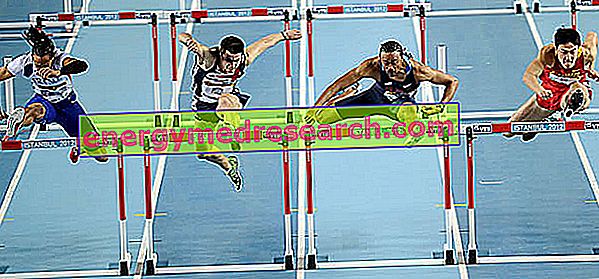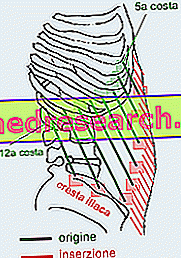Let us begin by pointing out that, unlike the other fast-running disciplines, the obstacle course (hs) requires such a high level of demonstrative precision and accuracy that, while deepening the details in detail, it would be almost totally useless for strictly progressive purposes- didactic, and therefore executive, of the athletic gesture. Ultimately, in the following chapter, the basic principles and characteristics of the obstacle course will be described, but without going into too much about it; to acquire a specific and in-depth technical and methodological knowledge it would therefore be necessary to cultivate discipline on the garment, supported by a sports technician specialized in athletics.
Preface
The athletics obstacle races are framed as fast races and, at a competitive-professional level, they include 2 disciplines: high obstacles (110m for men and 100m for women) and low obstacles (400m).
The difference between the flat fast race and the obstacle course basically consists in the ability to overcome repeated obstacles, of the same height, similarly distant from each other, maintaining the highest possible speed; the presence of obstacles implies a RIGIDITY OF THE RELATIONSHIP BETWEEN THE WIDTH OF THE STEP AND THE DISTANCE OF THE OBSTACLES THAT REQUIRES TO MODIFY THE TECHNIQUE OF THE QUICK RUN.
In the men's 110m, from the start to the 1st obstacle there are 2 rhythmic possibilities: 7 or 8 steps, but among the fastest athletes the second choice stands out greatly. In the 100 women a single 8-step solution is provided, while in the 400m the number of steps between the start and the first obstacle depends on the rhythm used successively between the obstacles themselves with a RELATIVE width (from 2.5m to 1, 9m for a number that oscillates from 13 to 17 intermediate steps).
NB . The choice of the athlete must be oriented as much as possible to the natural amplitude supported in the tests on the plan and, in the case of an intermediate number (eg 14-15 steps), at youth level there is a tendency to prefer the number of steps that favors the frequency rather than amplitude.
Among the cadet competitions there is also a 300m obstacle race, which uses 7 76cm barriers; it is characterized by an almost straight start with the first obstacle at 50m, and the other at 35m. In this competition the indications for the 400m apply, except for the attack on the first obstacle which involves about 3 more steps; for the purposes of a correct performance it is recommended to: always use an odd number of steps, in order to always use the same attacking leg (better the left), choose a sustainable width until the end of the race, develop an attack technique on the 'obstacle with both legs but, during training, NEVER alternate (perform the exercises first with the left leg first and then all with the right leg).
Training of the passage of the obstacle in the fast obstacle race of athletics
The passage of the obstacle differs in 4 phases:
- 1st phase or attack on the obstacle: the knee of the first leg must be as high as possible when the second leg, straight towards the obstacle, detaches from the ground; the angle of the knee is very closed while the foot is brought under and forward to the knee itself
- 2nd phase or overcoming of the obstacle: the foot that has passed the obstacle is already pointing towards the ground, the arms from collections open outwards with the elbows upwards and the hands flexed forward; the thigh of the second leg is parallel to the barrier
- 3rd phase or landing: the grip with the ground occurs in the forefoot and with the limb completely extended, requiring the SOLO cushioning of the tibio-tarsal joint (ankle); the contact time is short, as long as there is the right balance of the body segments (obtained and maintained between the 1st and 2nd phase)
- 4th phase or restart of the race: the second leg, called the recall leg, is well closed to the knee and with a continuous movement advances out of the way taking up the running line, determining the first step of recovery.
In the 400m hurdles, each barrier presents a different situation, such as obstacles when cornering, faced alternately and at different speeds from the 1st to the 10th obstacle.

Exercises for the improvement and consolidation of the technique of passing the obstacle
Imitative exercises: they are gaits with or without obstacles that conclude the heating of the specialty; in youth categories they are highly trained while in advanced athletes they act as targeted heating. First leg, second leg and central pass exercise; in advanced athletes must be performed ONLY if necessary.
Analytical exercises: they perfect the technique by using obstacles of different heights and that have different distances between them (more or less steps); also in the youth categories they are highly trained while in advanced athletes they act as targeted heating
Synthetic exercises: they represent the gradual transition between all the analytical exercises and the rhythm of the competition
Rhythmic exercises: 100 and 110 obstacles: keeping the rhythmic action unchanged may vary the distances and / or height of the obstacles; 400 obstacles: with fewer steps that allow you to develop a width similar to that of the race but with more obstacles available. They are useful for the preparatory cycles, while for the athlete evolved only for the pre-competitive cycle; they are the primary structure of training with a maximum of 40-50hs per session.
Race rhythmic exercises: race distances and heights are respected with repetitions that may include all or part of the race; they are the most correlated exercises with the race step and are fundamental in the preagonistic and competitive cycles. Max 20-25hs per session.
Gaits without step hs: first leg exercise, second leg and first + second leg together; the first two exercises can be performed with normal gaits, such as step and deadlift and with bounce on the foot of the supporting limb.
Gaits with hs: exercise of first leg, second leg and central; in these exercises the obstacles are placed at 100-150cm and the execution with simple movements or with bounce of the support foot.
NB . The analytical exercises, the synthetic ones, the 400m obstacle rhythm for advanced athletes and the 150m curve rhythmic exercise with hs are topics that, as anticipated in the introduction to the article, deserve to be tackled directly on the field and side by side to a specialized technician. In this chapter, even quoting them, we would only risk creating confusion among novice readers.
Youth training schedule
The programming of youth training is, as for the other disciplines, a difficult topic that MUST be at least "sketched"; not so much for the technicians as for the students, it is necessary to transmit the right guideline for an effective but safe planning of training in relation to the age and level of preparation of the athlete. Obviously it is not possible to report ALL the preparation cycles in relation to the different categories, therefore we will cite only a couple of examples below (in my opinion, the most delicate): Annual cycle for students NOT evolved in 110 / 100m hurdles and cycle annual for seventeen year old 400m hurdles.
Students / and 110 / 100m hurdles
| Introductory cycle | ||||||
| Monday | Tuesday | Wednesday | Thursday | Friday | Saturday | Sunday |
| General power | Power | Rest | Analytical hs technique | Rest | Power | Rest |
| Analytical hs technique | Race technique (gaits) | Speed | General power | Race technique (gaits) | ||
| Aerobic power | ||||||
| Basic cycle I | ||||||
| Monday | Tuesday | Wednesday | Thursday | Friday | Saturday | Sunday |
| Analytical hs technique | General power | Rest | leaps | Rest | Analytical and rhythmic technique | Rest |
| Speed | Power | Speed | ||||
| paces | ||||||
| Aerobic power | ||||||
| or | ||||||
| Monday | Tuesday | Wednesday | Thursday | Friday | Saturday | Sunday |
| Analytical hs technique | Power | General power | Rest | Analytical and rhythmic technique | leaps | Rest |
| Speed | Speed | Aerobic power | Speed | |||
| Basic cycle II | ||||||
| Monday | Tuesday | Wednesday | Thursday | Friday | Saturday | Sunday |
| leaps | Rhythmic | Rest | Power | Rest | Rhythmic | Rest |
| Speed | Race rhythm | Speed | Race rhythm | |||
| or | ||||||
| Monday | Tuesday | Wednesday | Thursday | Friday | Saturday | Sunday |
| Analytical hs technique | Power | Speed | Rest | Rhythmic | leaps | Rest |
| Race rhythm | Elastic gaits | Speed | ||||
| progressive | ||||||
| Special cycle | ||||||
| Monday | Tuesday | Wednesday | Thursday | Friday | Saturday | Sunday |
| Rhythmic | leaps | Rest | Analytical hs technique | Rest | Analytical hs technique | Rest |
| Speed | Rhythmic | Speed | ||||
| or | ||||||
| Monday | Tuesday | Wednesday | Thursday | Friday | Saturday | Sunday |
| Rhythmic | Rest | leaps | Analytical hs technique | Rest | Race rhythm | Rest |
| Speed | Rhythmic | |||||
Seventeen year old 400m hurdles
Introductory cycle | ||||||
| Monday | Tuesday | Wednesday | Thursday | Friday | Saturday | Sunday |
| Hs. Technique | Uphill pace | Hs. Technique | Leap over short and long distances | Hs. Technique | Skip and jump uphill | Rest |
| Muscle power with and without overload | Go up 50-60-80m | Analytical muscle power | Running rhythm | Muscle power with and without overload | Go up 60-100m | |
| Analytical speed | Aerobic power, fractional tests | Accelerations | Cross with rhythm variations | Compensation exercises | Cross at increasing speed | |
| Continuous cross 5 / 8km | 8/20 stretch on lawn | lengthen | ||||
| Fundamental cycle | ||||||
| Monday | Tuesday | Wednesday | Thursday | Friday | Saturday | Sunday |
| Hs. Technique | Short and long leaps | Technique and rhythmic hs | Running rhythm | Hs. Technique | Skip and jump | Rest |
| Muscle power with overload (few series) | Towing 50-60m | Analytical muscle power (strength resistance circuit) | Specific resistance | Muscle power with and without overload | Go up 60-100m | |
| Analytical speed | Mixed aerobic power (repeated series) | Accelerations | Cross at increasing speed | Aerobic power in fractionated tests | ||
| Specific resistance to speed | lengthen | |||||
| Special cycle | ||||||
| Monday | Tuesday | Wednesday | Thursday | Friday | Saturday | Sunday |
| Hs. Technique | leaps | Technique and rhythmic hs | Synthesis tests 150-300m | Hs rhythmic tests | Reactivity | Rest |
| Reactivity | Long tests of resistance to speed (repeated tests) | Cross at increasing speed | Short and long time mixed speed resistance | |||
| Competitive cycle | ||||||
| Monday | Tuesday | Wednesday | Thursday | Friday | Saturday | Sunday |
| Rest or discharge | Hs rhythmic tests | leaps | Reactivity | Sprint from the blocks | Rest before the race | Race or rest |
| Accelerations | Rhythmic tests with hs | lengthen | ||||
| Sprint from the blocks | ||||||
| lengthen | ||||||
Bibliography:



